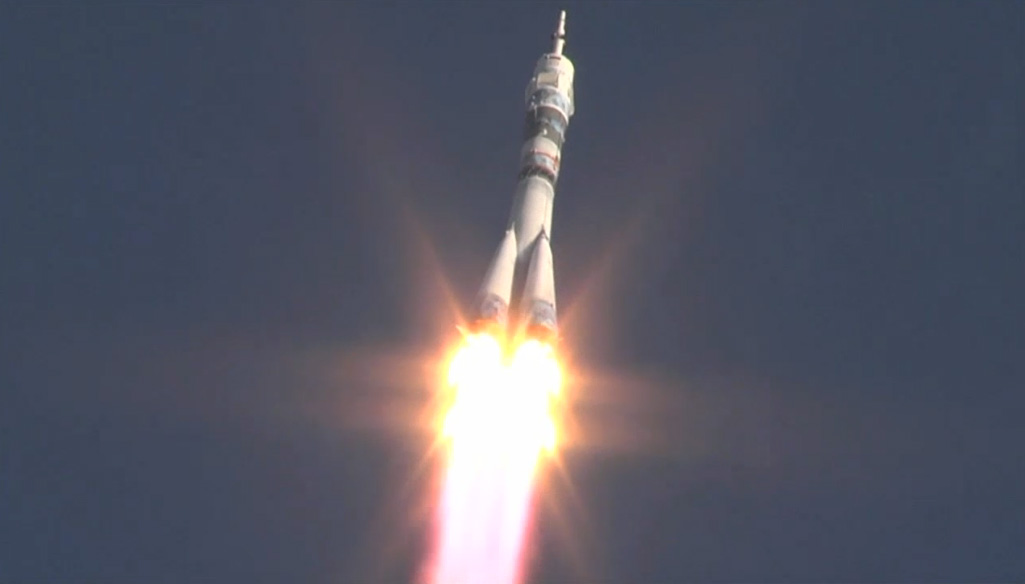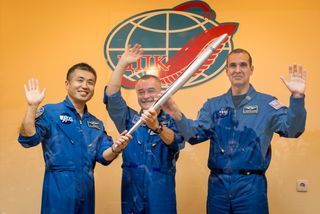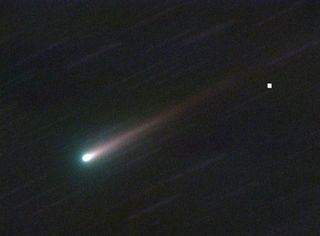Olympic Torch Launches Into Orbit with New Space Station Crew

A torch for the 2014 Sochi Olympics lifted off for the International Space Station on Wednesday night (Nov. 6), accompanied by three new crewmembers for the orbiting outpost.
Russian cosmonaut Mikhail Tyurin, NASA astronaut Rick Mastracchio and Koichi Wakata of the Japan Aerospace Exploration Agency (JAXA) launched on Russia's Soyuz TMA-11M spacecraft from the Baikonur Cosmodrome in Kazakhstan. Their Soyuz FG rocket climbed spaceward at 11:14 p.m. EST (0414 GMT; 10:14 a.m. Kazakh local time Nov. 7), marking the start of the crew's four-orbit, six-hour journey to the station.

The booster and its launch pad was specially-outfitted for this flight to celebrate the torch being aboard and the 22nd Winter Games being hosted in Sochi, Russia. The rocket and the protective shroud shielding the Soyuz TMA-11M spacecraft were decorated with Olympic-inspired graphics. The launch pad was equipped with metal Olympic rings.[See more launch photos for the space-bound Olympic torch]
"The Olympic torch, in the history of mankind, is probably the most ancient symbol of peace," Tyurin said during a pre-launch press conference. "It is a great pleasure and it is a great responsibility we are to work with this symbol of peace."
"I think it's great that we're bringing this symbol [of peace] up to the space station, which is another representation of international cooperation," Mastracchio added. "It is great that we can tie these two events, the Olympics and the International Space Station. We are happy to be a small part of it." [Related: Astronaut taking treasure-hunt 'travel bug' to space station]
The unlit torch and the three crew members docked at the station at 5:27 a.m. EST (1027 GMT) Thursday (Nov. 7).
About two hours later at 7:44 a.m. EST (1227 GMT), the hatches between Soyuz TMA-11M and the space station were opened. Tyurin, Mastracchio and Wakata were met onboard by Expedition 37 commander Fyodor Yurchikhin, NASA astronaut Karen Nyberg and Luca Parmitano of the European Space Agency, who have been in space since late May, as well as Oleg Kotov and Sergey Ryazansky of Roscosmos and NASA's Mike Hopkins, who arrived at the space station in September.
Get the Space.com Newsletter
Breaking space news, the latest updates on rocket launches, skywatching events and more!
This is the first time since October 2009 that nine people have served together aboard the station without a space shuttle being docked to the orbital complex.Normally, the outgoing crew — in this situation, Yurchikhin, Nyberg and Parmitano — would have already left for Earth, but the schedule was adjusted to facilitate the handoff of the Olympic torch.

Orbital Olympic relay
The aluminum red and silver torch, which is similar to the 14,000 others being used in the traditional terrestrial relay now crossing Russia but for the addition of an extra tether, is the third Olympic torch to fly in space. Previous torches flew on the space shuttle in 1996 and 2000, with the latter even coming aboard the International Space Station.
The 2014 Sochi Olympics torch will still set a first as it is taken outside on a spacewalk. The extravehicular activity (EVA) is scheduled to begin at 9:30 a.m. EST (1430 GMT) on Saturday (Nov. 9).
Expedition 38 commander Oleg Kotov and flight engineer Sergey Ryazansky will carry the torch with them on their outing, during which video and photographs will document the Olympic icon floating above the Earth.
The torch will then be brought back inside and returned to Earth on Sunday (Nov. 10), landing on board Soyuz TMA-09M with Yurchikhin, Nyberg, Parmitano.
Three months later, the space-flown torch will enter Fisht Olympic Stadium in Sochi to begin the Winter Games on Feb. 7, 2014.

Meanwhile, Tyurin, Mastracchio and Wakata will be on the space station through May 2014.
The trio are all veterans of spaceflight. Expedition 38/39 is Tyurin's third long-duration mission and his second stay aboard the International Space Station. Mastracchio and Wakata have each flown to space three times before.
"You're probably one of the most experienced crews that we've flown, so I cannot think of a better crew to represent the countries who built and operate the largest peacetime project in human history," NASA's space station program manager Michael Suffredini told the crew.
Wakata will become the first Japanese commander of the International Space Station when he takes the lead of ISS Expedition 39 beginning in March.
In addition to participating in the Olympic relay, the three will conduct hundreds of science experiments and oversee the arrival and departure of as many as seven resupply spacecraft, including three Russian Progress vehicles and both SpaceX and Orbital Sciences U.S. commercial cargo freighters.
Click through to collectSPACE.com for continuing coverage of the 2014 Sochi Olympics torch’s journey to the International Space Station.
Editor's Note: This story was updated at 8:15 a.m. ET to include details on the times of docking and hatch opening of the Soyuz spacecraft.
Follow collectSPACE.com on Facebook and on Twitter at @collectSPACE. Copyright 2013 collectSPACE.com. All rights reserved.
Join our Space Forums to keep talking space on the latest missions, night sky and more! And if you have a news tip, correction or comment, let us know at: community@space.com.

Robert Pearlman is a space historian, journalist and the founder and editor of collectSPACE.com, an online publication and community devoted to space history with a particular focus on how and where space exploration intersects with pop culture. Pearlman is also a contributing writer for Space.com and co-author of "Space Stations: The Art, Science, and Reality of Working in Space” published by Smithsonian Books in 2018. He previously developed online content for the National Space Society and Apollo 11 moonwalker Buzz Aldrin, helped establish the space tourism company Space Adventures and currently serves on the History Committee of the American Astronautical Society, the advisory committee for The Mars Generation and leadership board of For All Moonkind. In 2009, he was inducted into the U.S. Space Camp Hall of Fame in Huntsville, Alabama. In 2021, he was honored by the American Astronautical Society with the Ordway Award for Sustained Excellence in Spaceflight History.
